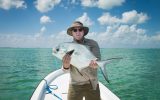On Wendy’s recent family trip to Belize, while she was road-testing Belize trip-planning specialists and her 14-year-old was learning to scuba dive, her husband, Tim, went fishing. Here’s his story:
“There they are, Mr. Tim!” Richard whispered with excitement. “Do you see them?”
“Uh…no.”
“Just cast hard as you can to one o’clock.”
I reared back with the spinning rod and let my bait fly. My bait was a small, live crab—with a total weight of about 40 cents’ worth of dimes—that was quickly rejected by the light breeze, as if I were taking a set shot against LeBron.
“Try again, Mr. Tim. Three o’clock this time!”
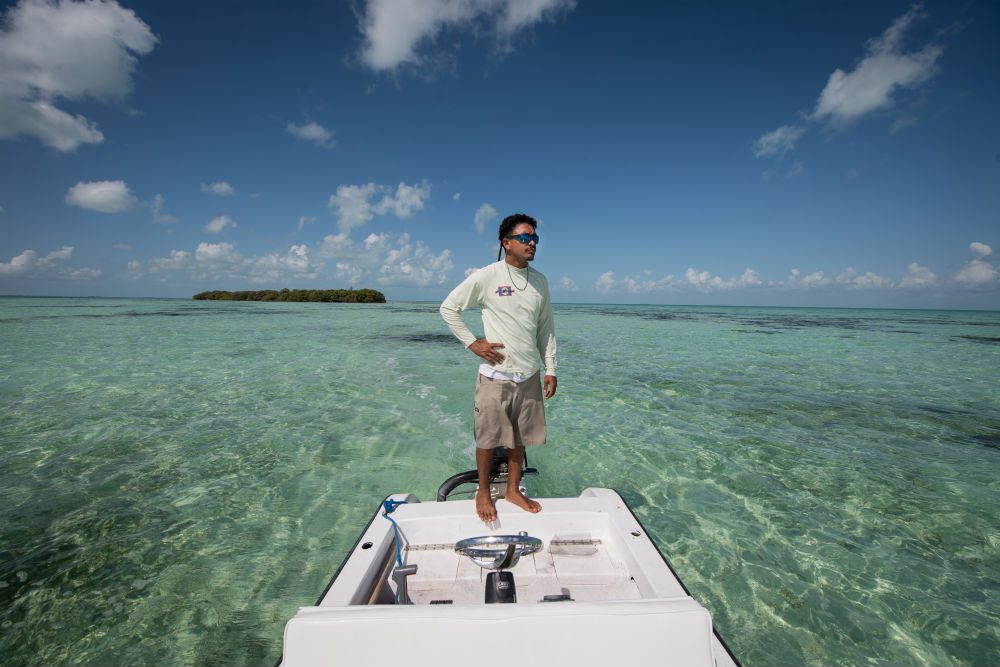
Richard Quillan, Belize fishing guide, on the lookout for western Atlantic game fish.
This time I cast just barely better. A blink later, I felt titch, titch, TUG! Wham! I set the hook! I set it so hard I’m surprised I didn’t jerk the fish clean out of the water. The fish pulled hard. Really hard. It pulled in an arc, first to one side and then a quick turn to the other. Like a metronome. Click, click, click.
On its fourth arc, Richard reached in and loosened the drag on the reel. Zizzzzzzzzzz! The fish took off on a dead run in front of the boat, taking the line with it as it raced off.
“Mr Tim, tell me if you think it could spool out!”
“Okay, I’m telling you right now!”
I had about a dozen winds left on the reel. More than 200 yards of 12-pound test line was gone in a flash. Richard quickly started the 50 HP outboard, and the chase was on. As we gained on the speeding fish, I was able to quickly recover a sizable amount of line back to the safety of the reel. If the line had come to a halt too abruptly, the fish could have snapped it. Not only would I not have caught the fish, but I would have left a fish with a hook in its mouth, and—much, much worse—yards and yards of monofilament fishing line floating forever in the shallow flat. And I would have felt awful about that.
Now that half the line was back on the reel, the give-and-take with the fish began in earnest. The contest had been all fish, but now I was winning the pull-hard-reel-in-quickly battle. The tiring fish even got close enough that I could see it. It looked like a chrome hubcap from a 1960s Cadillac, flashing in the bright sun. Just when I was ready to take the final pull to the boat, it took off again in full sprint. Go ahead, I thought. I have plenty of line restocked, and the boat is paid for until 4 p.m., and I know you are getting tired.
It took a full 20 minutes to get the line close enough to the boat, where Richard could land the fish. One thing about a permit fish: The tail has a great place to grip. Think of grabbing an hourglass in the middle. Once you’ve got it, you’ve really got it! I gave Richard a two-second lesson in how to use my camera, and he took two photos of me with my trophy.
Then, since fishing in Belize is catch-and-release (which I do anyway), Richard thanked the fish, gave it a kiss, and eased my catch of a lifetime back into the water. Despite its ordeal, it was off, in a flick of a tail.
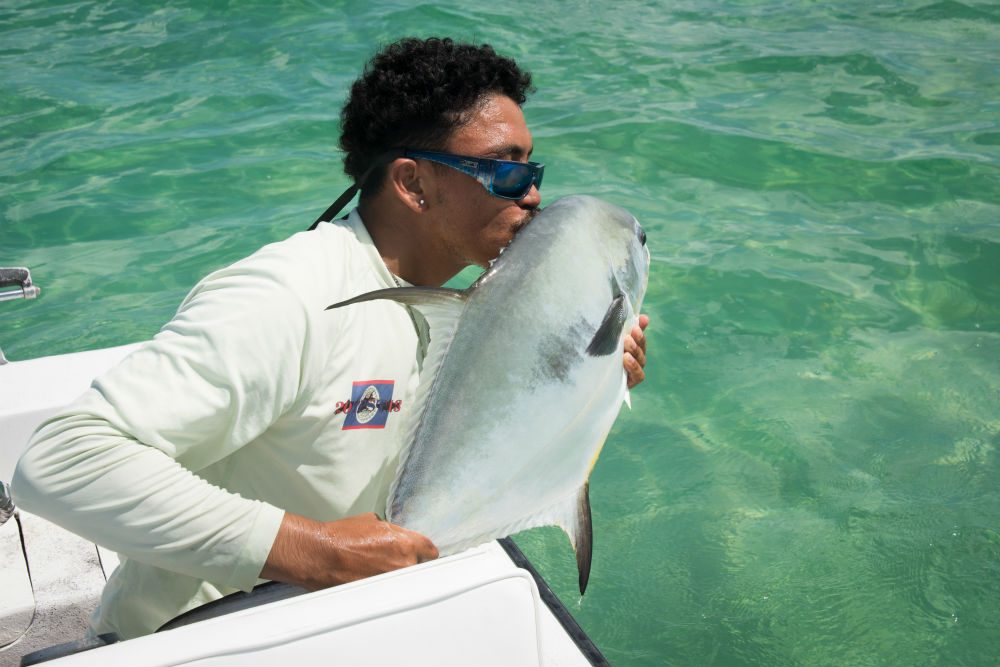
Richard thanks the fish, kisses it, and releases it back into the water.
Richard Quillan, my fishing guide, seemed genuinely as thrilled as I was. High-fives all around. Any professional guide wants the customer to be happy. Which I sure was. And this was Richard’s 26th birthday.
We reloaded a new crab and went in search of more.
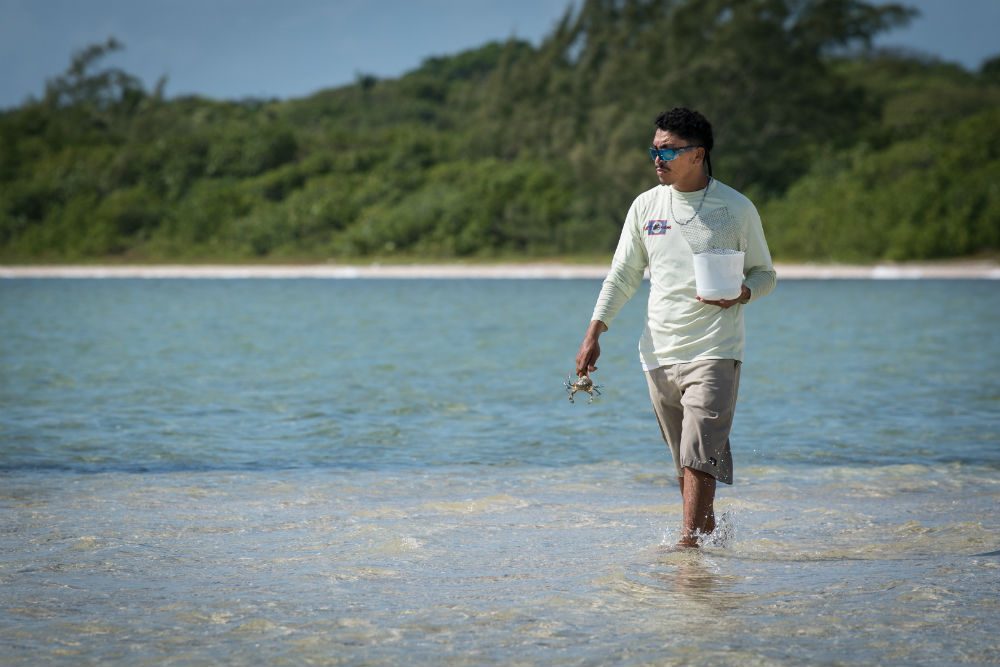
Catching crabs for fish bait
Belize is world-renowned for its flats fishing. Square mile after square mile of flats surround much of the country’s coastline and islands. The water is only a couple of feet deep.
The Permit is one-third of the Grand Slam of Belize fishing: Permit, Bonefish, and Tarpon. (Unlike baseball, golf, tennis, and breakfasts, it takes only three to make up a Belizean Grand Slam. Maybe the fourth thing to catch is a sunburn. And that’s guaranteed.)
The day before, I had hired Richard for a half-day bonefishing trip as a kind of warm-up. We had caught a couple of small bonefish, but I wasn’t thrilled by their fight. (I’ve had better battles with bigmouth bass in the lake I go to each summer.) Initially, for my full-day trip, I wanted to go for 100-plus-pound tarpon—considered by many one of the ultimate sports-fishing trophies—but Richard suggested, based on conditions, that we would have better luck going for permit.
While I enjoy fishing, the sight-casting approach didn’t really appeal to me. The hardest part was finding the fish. That’s where a fishing guide earns his value: In addition to a decade of experience, Richard had top-quality sunglasses—made for anglers—that helped him see into the water. With my regular glasses that darken in the sunlight, I felt like Mr. Magoo. Only late on the second day could I manage to start seeing the fish that Richard was pointing out to me.
If you want to see into the water, you need a bright, sunny, cloudless day, with not too much breeze chopping up the water surface. While a sunny day without a breeze is perfect for finding fish, be warned that under those conditions the sun is relentless. Even with temps in the mid 80s, you are just baking. These types of fishing boats have zero shade.
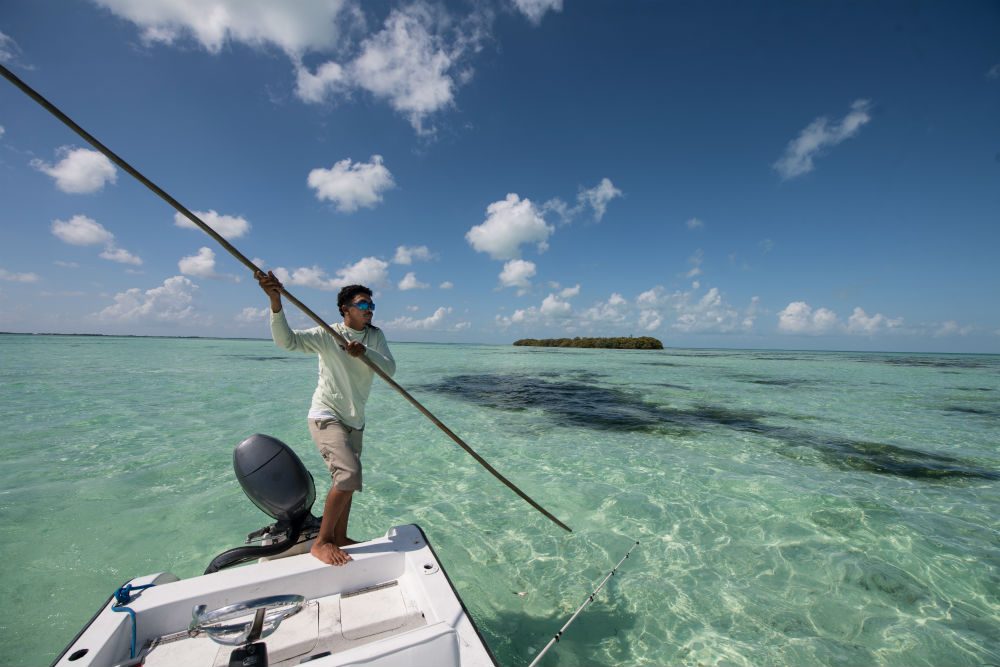
Poling the boat through the flats to intercept a school of fish that would have been scared off by the engine.
When Richard found the fish, we cut the outboard, and he poled us into position to intercept the school. Schools range from a handful to more than 50 fish. The fish are extremely shy, and that’s their defense in the shallow water of the flats: shyness, and sheer speed. Even our movements and voices on deck had to be muted. A misplaced cast (and there were many!), and the fish would scatter, and we’d need to look again in a new spot. In five hours of fishing, I landed three permits. Each was smaller than the last, but I was grateful for them all.
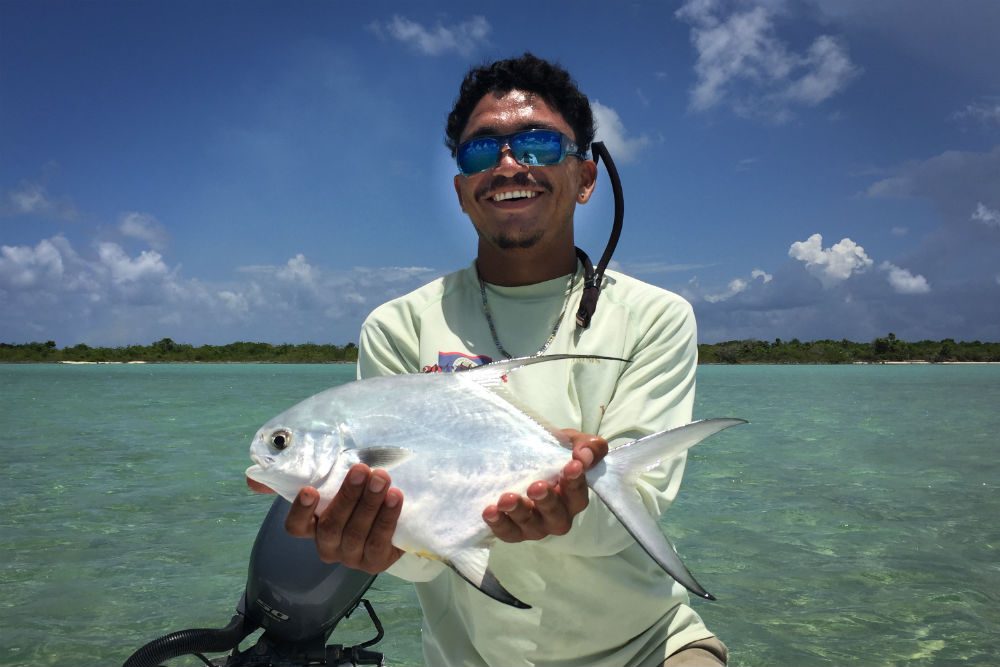
A small permit is jokingly called a “learner permit.”
Back at the dock, word got out, and I was hailed as the man who caught three permits in one day! Others have gone out and come up empty. But that’s fishing!
Next trip, bring on the tarpon!
Tim’s Tips for Fishing in Belize
Fishing in Belize is year-round, though some months are better than others. (July, August, and September are best for tarpon, for example.) My seven-hour day with guide, gear, and boat cost $500; the four-hour half-day cost $375. I also bought a one-week fishing license online for 50 Belize dollars (US $25). No one asked to see it, but I always support local fishing management programs.
I wish I had practiced casting at home before paying considerable money to scare away fish. Besides practicing pre-trip, here’s my hard-earned advice:
• If your main goal in Belize is to fish, choose a hotel close to the flats. T wo hours of my day were taken up just getting from our beachfront hotel to the flats and back again.
• Book a fishing guide in advance to guarantee that one is available on the day(s) you’ll be there. We arranged for Richard Quillan through our hotel.
• Check the weather report. Cloudy days make it hard for even the guides to find the fish. See how flexible the guide’s schedule is.
• Buy or borrow the best sunglasses for fishing you can find. When sight casting, it helps greatly if you can see into the water to spot the fish.
• On a boat made for casting, there is no shade. So cover up every part of your body with SPF protective clothing, and slather on the sunscreen. Even the guides get sunburned.
• Last but not least, always use fill flash for your photos.
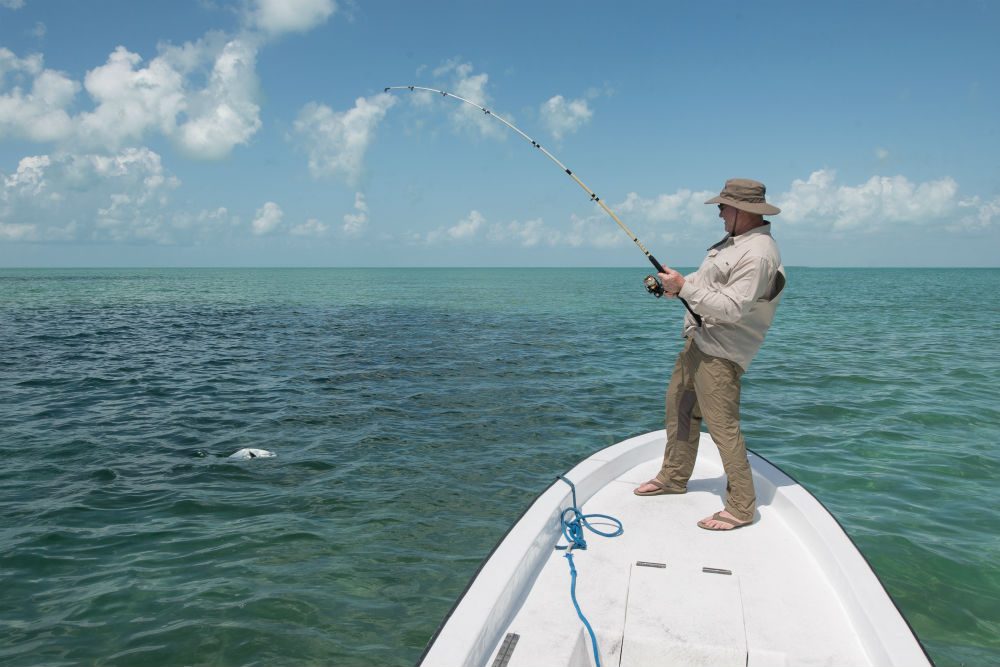
Covering up with protective SPF clothing is a must.
There’s lots more to do in Belize beyond fabulous fishing–you can fill your days by snorkeling the world’s second-largest barrier reef, exploring uncrowded Mayan ruins, learning about the Afro-indigenous Garifuna culture, and much more. Find inspiration for a trip to Belize in these reviews from your fellow travelers, then click the button below to get started planning your own trip.
Be a smarter traveler: Sign up for Wendy’s weekly newsletter to stay in the know. Read real travelers’ reviews, then use the black CONTACT buttons on Wendy’s WOW List to reach out to the right local fixer for your trip.

